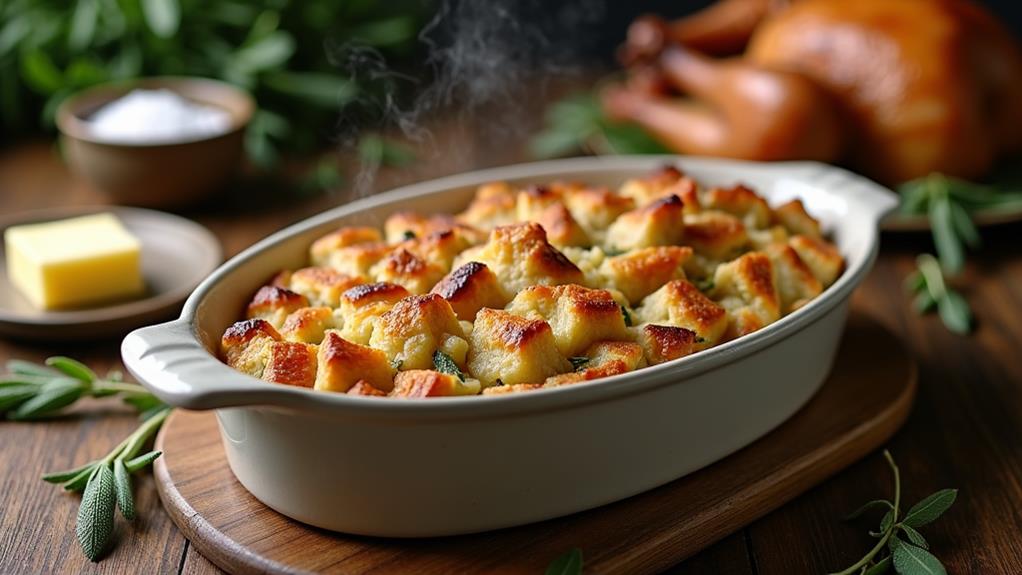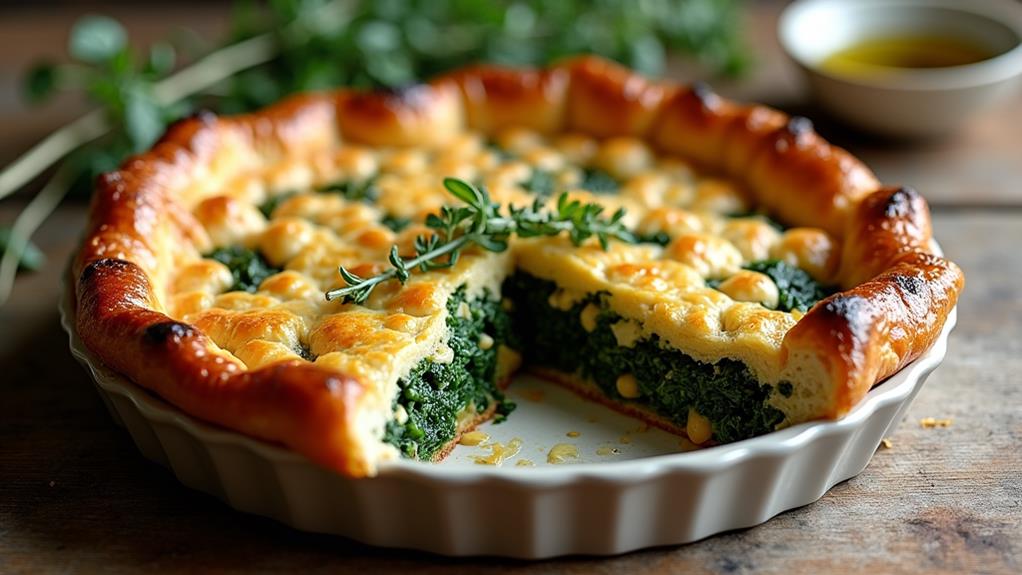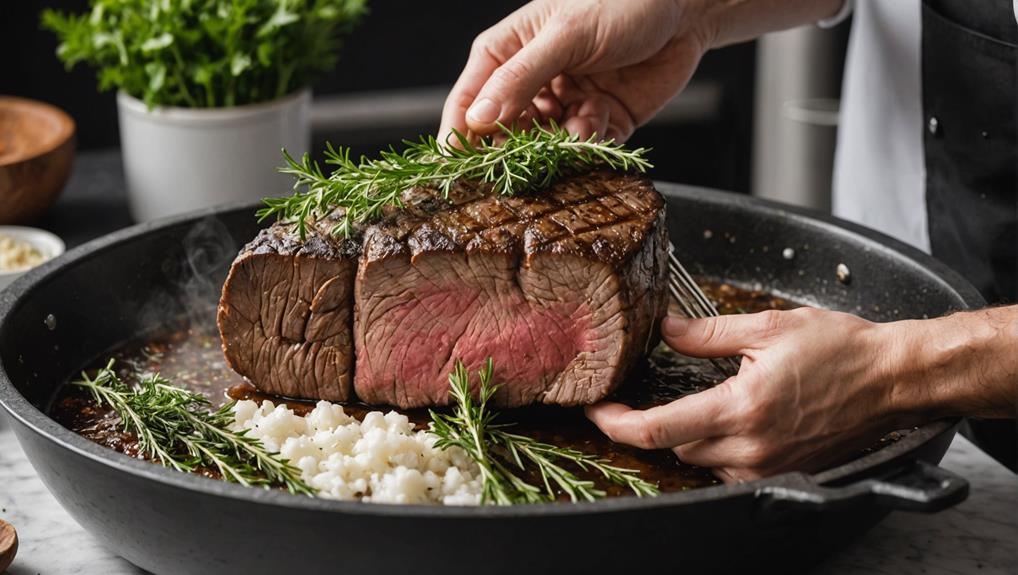Did you know that 85% of Americans consider stuffing an essential part of their Thanksgiving meal? Savory Sage and Onion Stuffing has been a holiday staple for generations, offering a comforting blend of flavors that perfectly complement roasted meats. You'll find this classic dish on tables across the country, with each family adding their own unique twist. Whether you're a seasoned cook or a curious novice, understanding the history and perfecting the recipe for this beloved side can elevate your holiday feast. Let's explore the secrets behind this timeless favorite and discover why it continues to captivate taste buds year after year.
Key Takeaways
- Savory Sage and Onion Stuffing is a classic side dish that pairs well with roasted meats, especially during holiday meals.
- Key ingredients include day-old bread cubes, diced onions, unsalted butter, dried sage, and chicken broth.
- The recipe involves sautéing onions in butter, adding sage, then combining with bread cubes and moistening with broth.
- Bake the stuffing covered at 350°F for 30 minutes, then uncovered for 15-20 minutes until golden brown and crispy.
- The dish can be customized with additional herbs or ingredients like apples, cranberries, or nuts for varied flavors and textures.
History
Stuffing's history dates back centuries, with its origins rooted in ancient Roman and Medieval European cuisine. You'll find that the concept of stuffing food with other ingredients has been around for millennia, with early recipes featuring mixtures of herbs, spices, and grains used to fill various meats and vegetables.
In medieval times, stuffing evolved into a more recognizable form, often including bread as a primary ingredient. This practice not only added flavor but also helped stretch limited food supplies.
As culinary traditions spread across Europe and eventually to the New World, stuffing recipes diversified, incorporating regional ingredients and flavors.
The sage and onion combination, which you now know as a classic stuffing flavor, gained popularity in England during the 16th century. This savory blend quickly became a staple in British cuisine, particularly for holiday meals.
When you prepare this traditional stuffing today, you're participating in a culinary tradition that has been passed down through generations, adapting and evolving along the way to suit modern tastes and cooking methods.
Recipe
Savory Sage and Onion Stuffing is a classic side dish that brings warmth and comfort to any meal. Its aromatic blend of herbs and vegetables creates a perfect accompaniment to roasted meats, particularly during holiday feasts. This simplified version focuses on the essential flavors while keeping the ingredient list short.
By using just five key components, you can achieve a delicious and satisfying stuffing that will impress your guests and complement your main course. The combination of crispy bread cubes, savory onions, and fragrant sage creates a harmonious balance of textures and flavors that will elevate your dining experience.
- 8 cups (500g) day-old bread cubes
- 2 cups (300g) diced onions
- 1/4 cup (60g) unsalted butter
- 2 tablespoons dried sage
- 1 cup (240ml) chicken broth
Melt the butter in a large skillet over medium heat. Add the diced onions and cook until softened and translucent, about 5-7 minutes. Stir in the dried sage and cook for an additional minute to release its flavors.
In a large mixing bowl, combine the bread cubes and the onion mixture. Gradually pour in the chicken broth, stirring gently to ensure even distribution. Transfer the mixture to a greased baking dish and cover with foil. Bake in a preheated 350°F (175°C) oven for 30 minutes, then remove the foil and bake for an additional 15-20 minutes until the top is golden brown and crispy.
For best results, use day-old bread that has been left out to dry overnight. This helps the bread cubes absorb the flavors without becoming too soggy. If you prefer a moister stuffing, you can add more broth, but be careful not to oversaturate the mixture.
Feel free to customize the recipe by adding other herbs like thyme or rosemary, or including diced celery for extra crunch. Remember that stuffing can be prepared in advance and refrigerated before baking, making it a convenient option for busy meal preparations.
Cooking Steps
To prepare this flavorful stuffing, you'll start by melting butter in a skillet and cooking the onions until they're soft and translucent.
Next, you'll add sage to the onions, cook briefly to release its aroma, and then combine this fragrant mixture with the bread cubes in a large bowl.
Step 1. Melt Butter in Skillet

In a large skillet over medium heat, melt the 1/4 cup (60g) of unsalted butter. As the butter begins to liquefy, you'll notice it slowly spreading across the pan's surface.
Keep a close eye on the process, as butter can quickly go from melted to browned. You're aiming for a completely melted state without any browning.
Once the butter has fully melted, it's time to add your diced onions. The melted butter will serve as the perfect medium for sautéing the onions, imparting a rich, savory flavor to your stuffing.
As you add the onions, you'll hear a satisfying sizzle as they hit the hot butter. Use a wooden spoon or spatula to gently stir the onions, ensuring they're evenly coated with the melted butter.
This step is crucial for developing the foundation of flavors in your stuffing. The butter not only adds taste but also helps to soften the onions and release their natural sweetness.
Step 2. Add Onions, Cook Until Soft
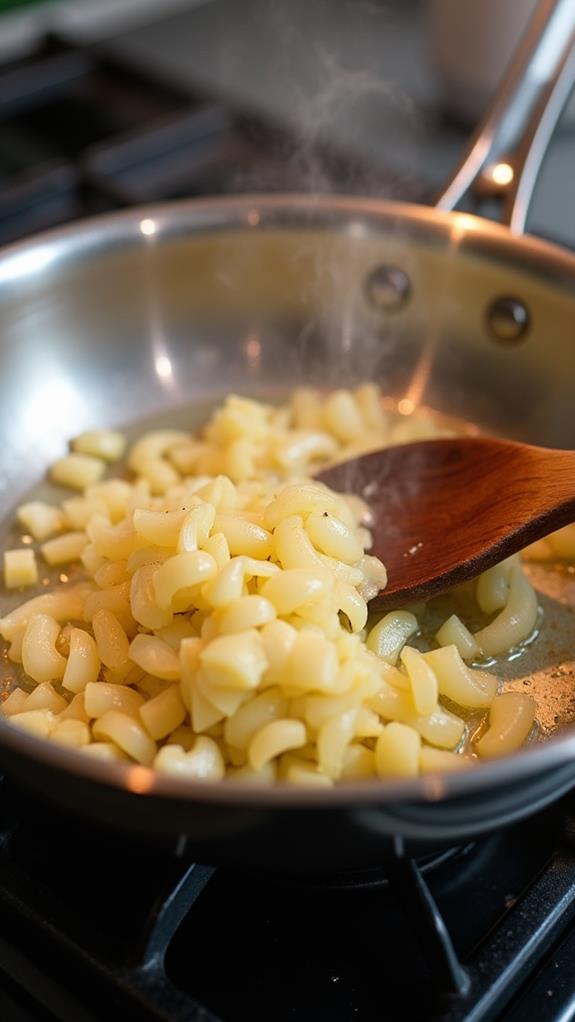
With the butter fully melted, it's time to add your diced onions to the skillet. Carefully pour the onions into the hot butter, ensuring they're evenly distributed across the pan's surface. You'll hear a satisfying sizzle as the onions make contact with the melted butter.
Using a wooden spoon or spatula, gently stir the onions to coat them with butter. Keep the heat at medium, allowing the onions to cook slowly and evenly. As they cook, you'll notice they become translucent and start to soften. This process typically takes about 5-7 minutes, but it's essential to keep an eye on them.
Stir the onions occasionally to prevent sticking and promote even cooking. You're aiming for a soft, translucent texture without any browning. If you notice the onions starting to brown, reduce the heat slightly.
The goal is to soften the onions while releasing their natural sweetness, which will enhance the overall flavor of your stuffing. Once the onions are soft and translucent, you're ready to move on to the next step in creating your savory sage and onion stuffing.
Step 3. Add Sage, Cook Briefly
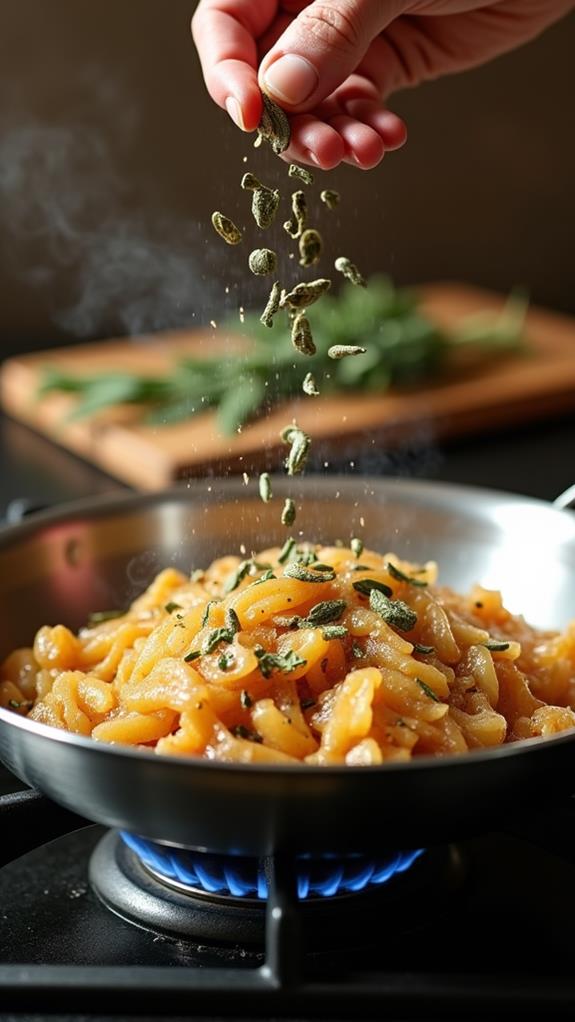
Once your onions have softened, it's time to toss in the dried sage. Measure out two tablespoons of the fragrant herb and sprinkle it evenly over the onions in your skillet.
Using a wooden spoon or spatula, gently stir the sage into the onions, ensuring it's well distributed throughout the mixture. As you do this, you'll notice the distinctive aroma of sage beginning to fill your kitchen.
Cook the sage and onion mixture for just about a minute. This brief cooking time is crucial, as it allows the sage to release its essential oils without burning.
You'll want to keep a close eye on the skillet during this step, stirring constantly to prevent any herbs from sticking to the bottom. The sage should become more fragrant, but be careful not to let it brown or crisp up.
Once you've reached the one-minute mark, remove the skillet from the heat. Your sage and onion mixture is now ready to be combined with the other stuffing ingredients, bringing a depth of flavor to your final dish.
Step 4. Combine Bread With Onion Mixture
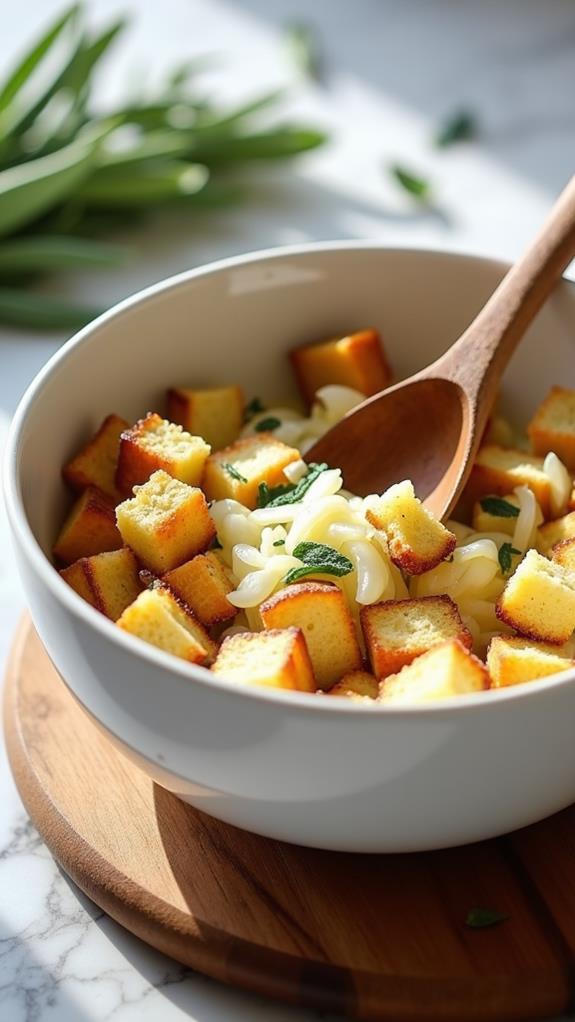
Ready to bring your stuffing together? Now's the time to combine your bread cubes with the flavorful onion mixture you've prepared.
In a large mixing bowl, add your day-old bread cubes, ensuring they're evenly distributed. Next, carefully pour the cooked onion and sage mixture over the bread, making sure to scrape all the buttery goodness from the skillet.
Using a large spoon or your hands (if they're clean), gently toss the bread and onion mixture together. You'll want to ensure that every bread cube gets a chance to mingle with the savory onions and fragrant sage.
As you're mixing, gradually pour in the chicken broth. Start with about half the broth, then assess the moisture level. You're aiming for the bread to be moist but not soggy. Add more broth as needed, stirring gently after each addition. The bread should absorb the liquid without turning into mush.
Once you've reached the right consistency, your stuffing mixture is ready for the next step: baking to perfection.
Step 5. Bake Covered, Then Uncovered
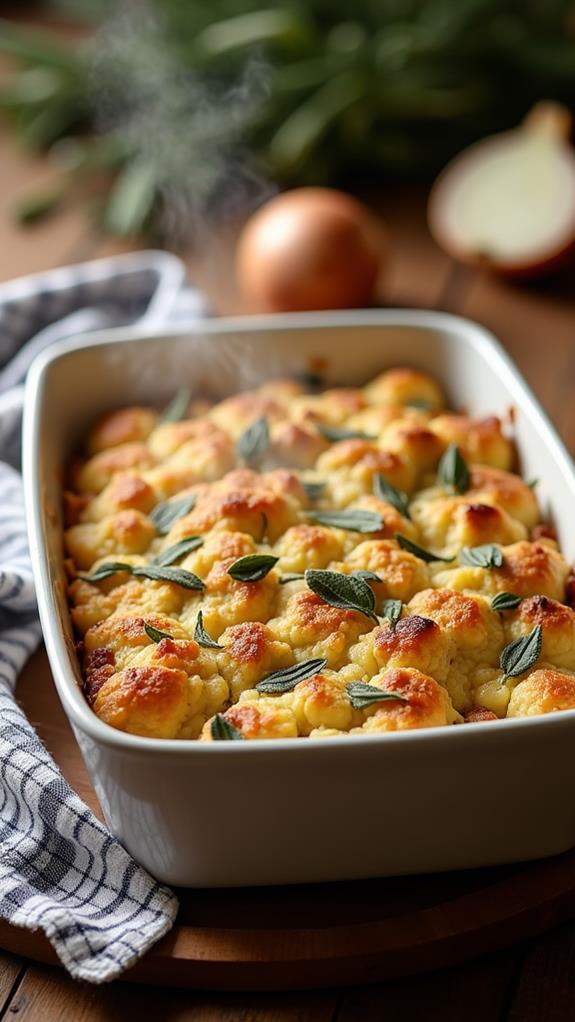
The final stage of preparing your savory sage and onion stuffing involves a two-step baking process. After you've combined the bread cubes with the onion mixture and chicken broth, transfer the stuffing to a greased baking dish. Cover the dish tightly with aluminum foil, ensuring no steam can escape during the initial baking phase.
Preheat your oven to 350°F (175°C) and place the covered dish on the middle rack. Bake for 30 minutes, allowing the flavors to meld and the stuffing to heat through evenly.
Once this time has elapsed, carefully remove the foil from the baking dish. Be cautious, as hot steam will escape when you uncover it. Return the dish to the oven, this time leaving it uncovered. Continue baking for an additional 15-20 minutes, or until the top layer turns golden brown and crispy.
This uncovered baking step creates a delightful contrast in texture, giving your stuffing a crisp exterior while maintaining a moist interior. Keep an eye on the dish during this final stage to prevent over-browning.
Final Thoughts
This classic stuffing recipe is a versatile and crowd-pleasing dish that you can easily adapt to suit your tastes. Don't hesitate to experiment with different herbs or add ingredients like chopped apples, cranberries, or nuts for extra flavor and texture.
If you're serving vegetarian guests, simply swap the chicken broth for vegetable stock.
Remember, the key to perfect stuffing lies in the bread's texture. If you don't have time to dry out your bread overnight, you can speed up the process by cutting it into cubes and toasting them in the oven for about 15 minutes at 250°F (120°C). This will help achieve that ideal balance of crispy exterior and moist interior.
For food safety, always cook stuffing separately from the turkey if you're preparing it for Thanksgiving. This ensures that both the bird and the stuffing reach safe internal temperatures.
Leftover stuffing can be stored in an airtight container in the refrigerator for up to three days. Reheat it in the oven to restore its crispy top before serving.

